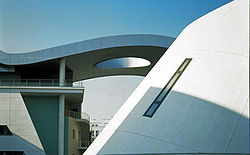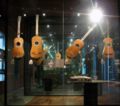- Cité de la Musique
-
The Cité de la Musique (French: City of Music) is a group of institutions dedicated to music and situated in the La Villette quarter, 19th arrondissement, Paris, France. It was designed by the architect Christian de Portzamparc and opened in 1995. It consists of an amphitheater; a concert hall that can accommodate an audience of 800-1,000; a museum of music, containing an important collection of classical music instruments dating mainly from the fifteenth- to twentieth-century; and exhibition halls, workshops and archives. Part of François Mitterrand's Grands Projets along with the Parc de la Villette, the Cité de la Musique reinvented La Villette - the former slaughterhouse district.[1]
Its official address is 221, Avenue Jean Jaurès, 75019 Paris.[2]
Contents
Philharmonie de Paris
The Paris Philharmonic (philharmonie de Paris), a 2400-seat symphony hall, had been planned for about 20 years and is now scheduled for completion by 2012. The announcement was made on March 6, 2006 by the French minister of Culture and communication Renaud Donnedieu de Vabres, the mayor of Paris Bertrand Delanoë, and the director of the Cité de la Musique, Laurent Bayle, at a press conference concerning the reopening of the Pleyel Hall, now associated with the Museum.[3]
The cost of construction of the new auditorium may reach EUR170 million, and will be paid for equally by the French Government and by the Ville de Paris, who has not excluded the possibility of funding from Région Île-de-France or the use of private financing.[4]
It was announced in April 2007 that the hall would be built by Jean Nouvel.
Musée de la Musique
The Museum of Music (Musée de la Musique) features a collection of several hundred musical instruments collected by the Conservatoire de Paris. The museum's collection contains instruments used in classical and popular music from the seventeenth century to the present time including lutes, archlutes, almost 200 classical guitars[5], violins by Italian luthiers Antonio Stradivari, the Guarneri family, Nicolò Amati; French and Flemish harpsichords; pianos by French piano-makers Erard and Ignaz Pleyel; and saxophones by Adolph Sax.
The instruments are exhibited by period and by type. Audio devices are provided at the entrance allowing visitors to hear commentary and excerpts of music played on the instruments.
Gallery
References
- Kim Eling, The Politics of Cultural Policy in France, Chapter 3: "La Cité de la Musique", Macmillan, 1999, pages 38-61. ISBN 0312219741.
- ^ Fierro, Annette; p. 17 (2003). The Glass State: The Technology of the Spectacle, 1981-1998. MIT Press. ISBN 026206233X.
- ^ "Plan and location of all the elements at the official website". Cité de la Musique. http://www.cite-musique.fr/anglais/cite/acces.html. Retrieved 2007-09-06.
- ^ "Renaud Donnedieu de Vabres et Bertrand Delanoë, maire de Paris, annoncent les partenariats noués entre l’Etat et la Ville de Paris pour le développement de la vie musicale symphonique à Paris" (Press release). Ministry of Culture and Communication. 2006-03-06. http://www.culture.gouv.fr/culture/actualites/communiq/donnedieu/pleyel06.html. Retrieved 2007-09-06. (French)
- ^ "La Cité de la musique bientôt achevée" (in French). Le Monde. 2006-03-07. http://www.lemonde.fr/web/article/0,1-0@2-3246,36-747865@51-729467,0.html. Retrieved 2007-09-06.
- ^ Les guitares classiques du Musée de la musique (almost 200 classical guitars); Instruments et oeuvres d'art - use search-phrase: Mot-clé(s) : guitare
See also
External links
- Cité de la Musique official website
- Médiathèque de la Cité de la musique (French) - Listen to excerpts of concerts
Categories:- 1995 establishments in France
- Museums in Paris
- 19th arrondissement of Paris
- Music museums
- Modernist architecture in France
Wikimedia Foundation. 2010.








